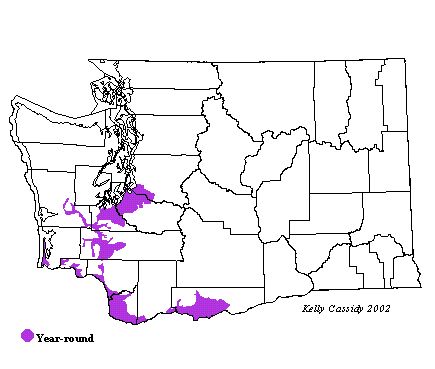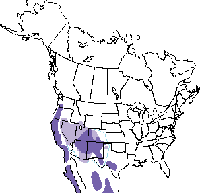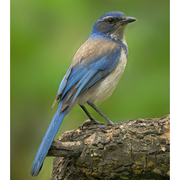California Scrub-Jay
General Description
Califonia Scrub-Jays are medium-sized, slender birds with long tails. The Western Scrub-Jay has blue upperparts, a grayish-brown back, and light underparts. It has a well-defined blue breast-band that contrasts with its white breast and throat. A white line just above each eye divides the blue crown from the darker cheek patches.
Habitat
California Scrub-Jays are typically found in oak woodlands. In Washington, they are also found in residential areas with low- to mid-density development.
Behavior
California Scrub-Jays usually forage in pairs, family groups, or very small flocks outside the breeding season. They forage on the ground and in trees, caching much of the food they find and retrieving it later.
Diet
California Scrub-Jays are omnivorous, with a diet that varies by season and region. In summer, they eat many insects, spiders, and snails, and in winter, they shift to berries, acorns, and other seeds. They eat rodents, reptiles, amphibians, and the eggs and young of other bird species. They also visit bird feeders.
Nesting
California Scrub-Jays are typically monogamous, and nest in shrubs or low trees. Both members of the pair help build the nest, which is a thick-walled cup made of grass, twigs, and moss, lined with soft rootlets and hair. The male brings food while the female incubates 3-6 eggs for 15-17 days. Both adults help feed the young, which leave the nest at 18-19 days. They typically raise one brood each year.
Migration Status
California Scrub-Jays do not migrate, but some birds disperse, particularly in fall, which has enabled the species to spread north into Washington.
Conservation Status
California Scrub-Jays have been expanding their range northward and eastward since the 1970s. This expansion is most likely due to increased residential development and feeding by humans, and will probably continue. In Washington, the breeding population has expanded from the Portland, OR and Vancouver, WA area, up and down the Columbia River, and northward to King County, with wandering birds found north to Skagit and Snohomish Counties.
When and Where to Find in Washington
California Scrub-Jays can be found regularly year round in western Washington lowlands from Puget Sound south. They are occasional as far north as Seattle and have been found breeding north of Enumclaw and in Seattle in small numbers (King County). They can be found rarely all the way to the coast in Grays Harbor County and east to Lyle in Klickitat County. Ridgefield Wildlife Refuge in southwest Washington is a good location for finding them.
 Abundance
Abundance
| Ecoregion | Jan | Feb | Mar | Apr | May | Jun | Jul | Aug | Sep | Oct | Nov | Dec |
|---|---|---|---|---|---|---|---|---|---|---|---|---|
| Oceanic | ||||||||||||
| Pacific Northwest Coast | U | U | U | U | U | U | U | U | U | U | U | U |
| Puget Trough | C | C | C | C | C | C | C | C | C | C | C | C |
| North Cascades | ||||||||||||
| West Cascades | F | F | F | F | F | F | F | F | F | F | F | F |
| East Cascades | F | F | F | F | F | F | F | F | F | F | F | F |
| Okanogan | ||||||||||||
| Canadian Rockies | ||||||||||||
| Blue Mountains | ||||||||||||
| Columbia Plateau |
Washington Range Map

North American Range Map


Family Members
 Gray JayPerisoreus canadensis
Gray JayPerisoreus canadensis Steller's JayCyanocitta stelleri
Steller's JayCyanocitta stelleri Blue JayCyanocitta cristata
Blue JayCyanocitta cristata California Scrub-JayAphelocoma californica
California Scrub-JayAphelocoma californica Pinyon JayGymnorhinus cyanocephalus
Pinyon JayGymnorhinus cyanocephalus Clark's NutcrackerNucifraga columbiana
Clark's NutcrackerNucifraga columbiana Black-billed MagpiePica hudsonia
Black-billed MagpiePica hudsonia American CrowCorvus brachyrhynchos
American CrowCorvus brachyrhynchos Northwestern CrowCorvus caurinus
Northwestern CrowCorvus caurinus Common RavenCorvus corax
Common RavenCorvus corax

